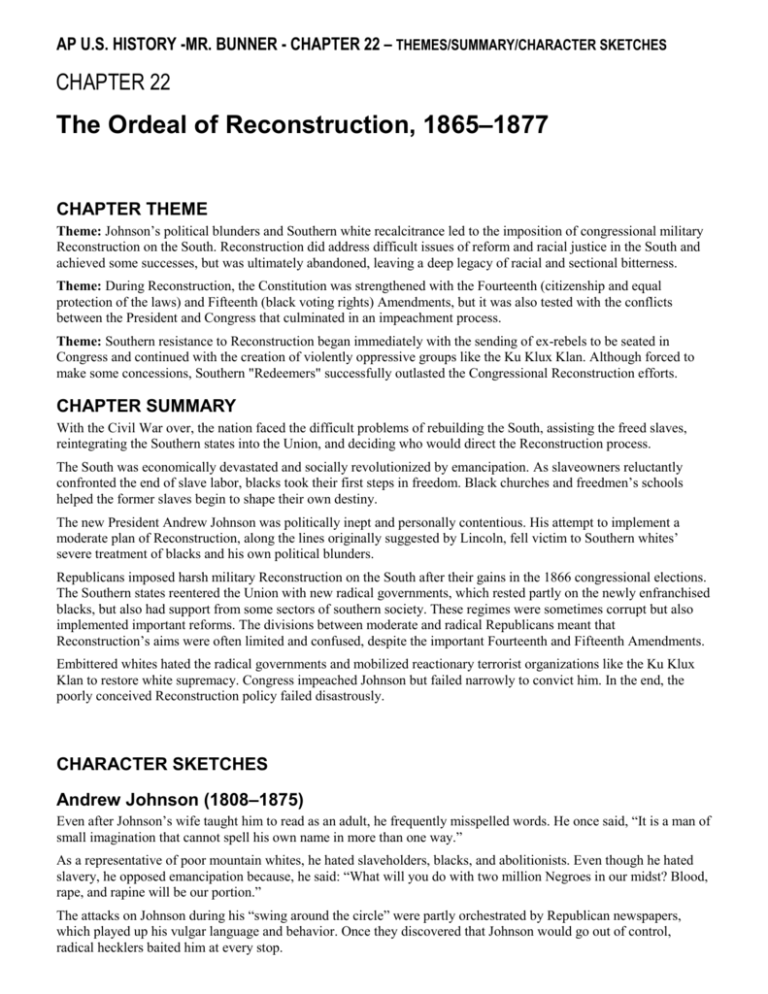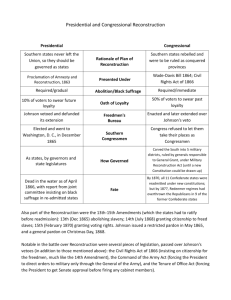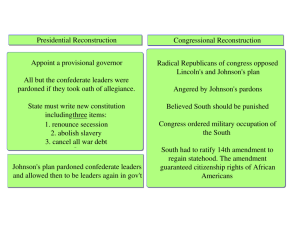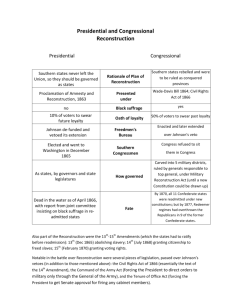22WIKI
advertisement

AP U.S. HISTORY -MR. BUNNER - CHAPTER 22 – THEMES/SUMMARY/CHARACTER SKETCHES CHAPTER 22 The Ordeal of Reconstruction, 1865–1877 CHAPTER THEME Theme: Johnson’s political blunders and Southern white recalcitrance led to the imposition of congressional military Reconstruction on the South. Reconstruction did address difficult issues of reform and racial justice in the South and achieved some successes, but was ultimately abandoned, leaving a deep legacy of racial and sectional bitterness. Theme: During Reconstruction, the Constitution was strengthened with the Fourteenth (citizenship and equal protection of the laws) and Fifteenth (black voting rights) Amendments, but it was also tested with the conflicts between the President and Congress that culminated in an impeachment process. Theme: Southern resistance to Reconstruction began immediately with the sending of ex-rebels to be seated in Congress and continued with the creation of violently oppressive groups like the Ku Klux Klan. Although forced to make some concessions, Southern "Redeemers" successfully outlasted the Congressional Reconstruction efforts. CHAPTER SUMMARY With the Civil War over, the nation faced the difficult problems of rebuilding the South, assisting the freed slaves, reintegrating the Southern states into the Union, and deciding who would direct the Reconstruction process. The South was economically devastated and socially revolutionized by emancipation. As slaveowners reluctantly confronted the end of slave labor, blacks took their first steps in freedom. Black churches and freedmen’s schools helped the former slaves begin to shape their own destiny. The new President Andrew Johnson was politically inept and personally contentious. His attempt to implement a moderate plan of Reconstruction, along the lines originally suggested by Lincoln, fell victim to Southern whites’ severe treatment of blacks and his own political blunders. Republicans imposed harsh military Reconstruction on the South after their gains in the 1866 congressional elections. The Southern states reentered the Union with new radical governments, which rested partly on the newly enfranchised blacks, but also had support from some sectors of southern society. These regimes were sometimes corrupt but also implemented important reforms. The divisions between moderate and radical Republicans meant that Reconstruction’s aims were often limited and confused, despite the important Fourteenth and Fifteenth Amendments. Embittered whites hated the radical governments and mobilized reactionary terrorist organizations like the Ku Klux Klan to restore white supremacy. Congress impeached Johnson but failed narrowly to convict him. In the end, the poorly conceived Reconstruction policy failed disastrously. CHARACTER SKETCHES Andrew Johnson (1808–1875) Even after Johnson’s wife taught him to read as an adult, he frequently misspelled words. He once said, “It is a man of small imagination that cannot spell his own name in more than one way.” As a representative of poor mountain whites, he hated slaveholders, blacks, and abolitionists. Even though he hated slavery, he opposed emancipation because, he said: “What will you do with two million Negroes in our midst? Blood, rape, and rapine will be our portion.” The attacks on Johnson during his “swing around the circle” were partly orchestrated by Republican newspapers, which played up his vulgar language and behavior. Once they discovered that Johnson would go out of control, radical hecklers baited him at every stop. Johnson remained a political hero to the plain whites of Tennessee following his departure from the presidency. After several tries he was reelected to the Senate in 1875 but attended only one session before he died. Quote: (In reply to hecklers’ shouts of “Judas!”): “There was a Judas, and he was one of the twelve apostles.…If I have played Judas, who has been my Christ that I have played Judas with? Was it Thad Stevens? Was it Wendell Phillips? Was it Charles Sumner?” (Swing around the circle, 1866) Oliver O. Howard (1830–1909) Howard was the Civil War general who became head of the Freedmen’s Bureau during Reconstruction. In the Battle of Fair Oaks, Howard lost his right arm. His Civil War record was somewhat mixed: he bungled several operations and once refused to obey an order from General Hooker. Considered a “Christian officer,” he was shocked by the destruction inflicted on Georgia by Sherman’s army, even though he justified it as militarily necessary. After leaving the Freedmen’s Bureau, he founded Howard University in Washington, D.C., and served as its president from 1869 to 1874. He caused a split in his church in Washington by demanding the admission of black members. Howard later returned to active military duty and commanded the 1877 expedition against the Nez Percé Indians in the West. He wrote frequently for newspapers and magazines and was a popular lecturer. Quote: “A brief experience showed us that the negro people were capable of education, with no limit that men could set on their capacity. What white men could learn or had learned, they, or some of them, could learn.” (Autobiography, 1907) Hiram Revels (1822–1901) Revels, a clergyman, became one of the two black senators from Mississippi during Reconstruction. Born a free man in Kentucky, Revels was of black and Indian ancestry. He first worked as a barber but then attended Knox College in Illinois and became a minister of the African Methodist Church. He organized two black regiments in Maryland during the Civil War and then traveled widely in the South promoting religion and education for blacks. He was first elected an alderman in Natchez, Mississippi, despite his concern about mixing religion and politics. Many whites as well as blacks liked him, and he was elected to take Jefferson Davis’s seat in the Senate. During his brief term he supported the moderate Republicans and not the radicals. He later came under white Democratic influence and joined in the overthrow of Republican Reconstruction in 1875. Quiet and mild-mannered, he disliked political conflict. Quote: “The colored members, after consulting together on the subject, agreed to give their influence and votes for one of their own race, as it would in their judgment be a weakening blow against color line prejudice, and they unanimously elected me for their nominee.…Some of the Democracy favored it because they thought it would seriously damage the Republican party.” (1884) Thaddeus Stevens (1792–1868) Stevens was the Republican congressman who led radical Reconstruction and engineered the impeachment of Andrew Johnson. Often sickly as a child, Stevens was partially physically disabled as an adult. He hated slavery from an early age and occasionally purchased fugitive slaves in order to give them their freedom. In Congress Stevens constantly attacked Southerners in scurrilous language, and some of his speeches nearly provoked riots on the floor of the House. As soon as the Civil War broke out, he advocated arming the slaves and encouraging a slave insurrection. His hatred of the South was increased when Confederate soldiers destroyed his ironworks during Lee’s invasion of Pennsylvania. Stevens was well read and eloquent but relied heavily on vituperation and sarcasm and seemed in a constant state of barely suppressed rage. He died shortly after the Johnson trial, but only his nephew and his black housekeeper attended his funeral. He chose to be buried in a black cemetery. Quote: “I repose in this quiet and secluded spot, not from any natural preference for solitude, but, finding other cemeteries limited by charter rules as to race, I have chosen this, that I might illustrate in my death the principle which I have advocated through a long life—Equality of Man before his Creator.” (Inscription on Stevens’s tombstone, written by himself, 1868)







